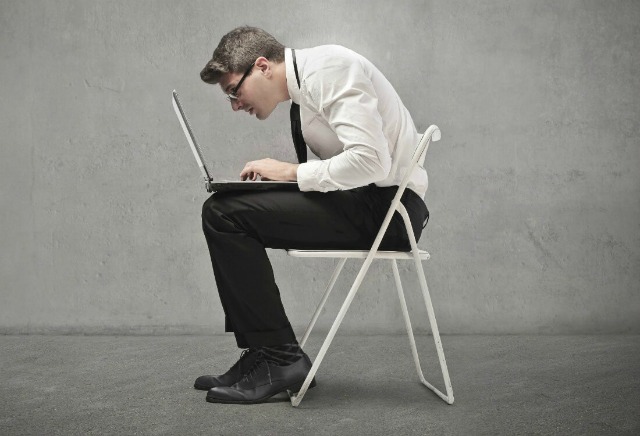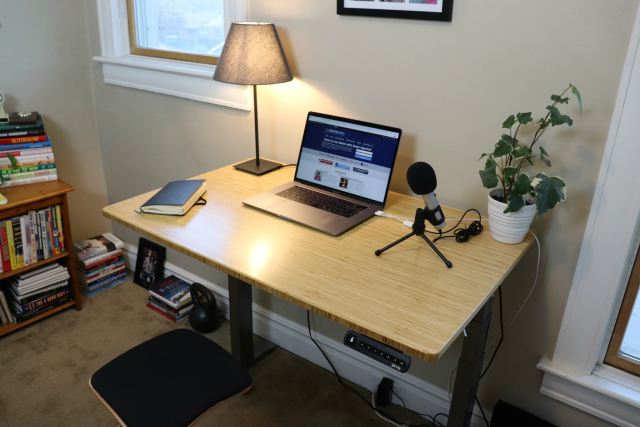When I first started running, I couldn’t finish a 3-mile run and was sore for two weeks. Was running supposed to make your legs feel like they went through a meat grinder?!

Me, feeling like my legs were put through a meat grinder. More carnage on Insta!
But soon, the feeling of being run over by a tractor subsided. As my fitness grew over the weeks and months, it was replaced by a feeling of strength.
I felt powerful and fast. Soon, I ran a sub-6:00 mile… and then 5:19 by the end of the indoor track season. I had never felt so athletic and in control of my body as I did during that first year of running.
Flash forward eight years after high school, college, and a combined 24 seasons of cross country and track and I started my first job.
My first memory? How sitting down for eight hours all day made my butt sore.
For the first time in my life, I was forced to spend a large majority of my day planted in a seat. And that feeling was the very opposite of how I felt as a new runner.
Gradually, I got used to sitting for prolonged periods of time. At no point did I have a fun ergonomic chair, an adjustable standing desk, or any way to mitigate the effects of being slumped in a chair for a third of the day.
When I started running after work, I noticed the difference:
- Warming up was harder and took longer
- I felt tight and stiff like I had just run a workout
- My running felt uncoordinated and “clunky”
I soon realized that going from “Couch to Track” was inviting injury and limiting my running performance.
Then, the effects of sitting for long periods of time started being studied.
The results left me worried that my lifestyle wasn’t just detrimental to my running, but my overall health and longevity. Running is important, but even more so is my general health.
But let’s step back for a minute.
Is Sitting Really That Bad For You?

Spending a majority of the day sitting down is quite bad for your general health – even if you run a lot!
A wide variety of studies (including this particularly scary one) summarize the negative effects of prolonged sitting. Sitting…
- increases your risk of heart disease, some cancers, obesity, and diabetes
- reduces HDL (or “good”) cholesterol in the body
- increases fatty acids in the blood
- Puts you at a great risk of dying…
To put salt in the wound, the science is clear that no amount of exercise will negate all that sitting. It’s an unhealthy behavior on its face because of how long your muscles go without any contractions.
Nevertheless, Americans are still spending an average of 13 hours per day sitting down.
Even if you’re running a lot, it won’t counterbalance all this sedentary behavior. It’s still unhealthy (just like if you smoked a pack of cigarettes per day and ran a lot).
Usually, you’ll read that the answer to this problem is an adjustable standing desk.
Standing is better than sitting, right? Not so fast.
Standing Desks are Not a Panacea

If you think that a standing desk will solve this problem, then unfortunately I have bad news: standing isn’t much healthier than sitting.
Prolonged standing has its own risks:
- Increased risk of back pain
- This study shows that standing for 6 hours per day doubles or triples your risk of needing surgery for varicose veins
- Excessive fatigue and lethargy
- Sore feet, swollen legs, and muscular stiffness
The New York Times recently ran a story decrying adjustable standing desks as overrated. Here’s a key excerpt:
Many health groups recommend that people at work take frequent walking breaks. Replacing sitting with standing does not fulfill that recommendation and may even mislead people into thinking they’re doing enough activity.
Standing is not exercise, after all.
But while standing desks will not improve your cardiovascular health and replacing sitting with standing is not recommended, that’s not really the argument I’m going to make here.
Thinking that you have to either sit for the day or stand all day is a false choice. The reality is that humans are made to move and we should continue that trend during the workday.
The Solution: Varied Movements
Instead of a binary choice of “sit or stand” we should take a more nuanced view of how to optimize our workday.
As creatures of movement, our best option is variety:
- Sit (helpful if you can sit in a variety of chairs)
- Stand
- Kneel or sit cross-legged
If we could take several recesses throughout the day to hit the playground, we’d all be better off.
That’s because we shouldn’t spend a large chunk of time in any one position because our muscles are plastic. They can be molded and shaped and they remember the positions that we put them in. If you slouch in front of your computer for a few decades, that’s just what your posture will look like…
All that time sitting will make your quadriceps and hip flexors tighten. If you spend all day standing, your lower back and feet will get stiff and sore.
In addition to varied positions throughout the day, we should always look for opportunities for more movement, too:
- Taking a phone call or short meeting? Walk around the office or around the block
- Use the printer on the other side of the office, forcing a quick walk
- Use your lunch hour productively to run, lift weights, or go for a walk
- Walk to your colleague’s desk rather than sending an email
- Use an ergonomic chair and desk setup to improve bodily positions
I’ve long tried to incorporate more movement into my day, but I haven’t optimized my desk. I was still sitting down in the same position for most of the day – and I could feel it.
But I’ve changed that: I’m now a proud owner of a Jarvis adjustable standing desk.
And I’ve never felt better.
The Jarvis Adjustable Standing Desk
A few months ago I reached out to Fully, a company that creates office furniture for active people. I wanted to prompt myself to sit down less during the day and Fully’s products would not only help me do that, but succeed in style.
I now have a Jarvis adjustable standing desk with a crazy stool called the Tic-Toc Chair. Check out my setup:

Like I mentioned before, standing (as opposed to sitting) is not a panacea. It’s not necessarily any healthier than sitting down because both, for prolonged periods of time, have major drawbacks.
But the answer to this conundrum is variety. Now I have options. I can…
- Sit on a stool that swivels and rocks back and forth (the rocking is a lot of fun!)
- Stand up (allowing me to move more freely)
- Kneel on the floor (I’m doing this as I’m typing; while not the most comfortable, 10-15 minutes at a time feels good)
- Pull a regular chair over and sit “normally”
Varying my movements and body positions throughout the day – instead of staying slumped in a chair for eight hours – helps me reduce soreness, avoid some of that inevitable afternoon drowsiness, makes it easier for me to transition to running after I’ve been working, and helps prevent injuries.
I also created a video about why runners should think about standing desks:
Besides the function of my Jarvis standing desk, I also love its style:
- The bamboo table top is attractive and one-of-a-kind
- The alloy metal is a stark contrast – in a good way
- Bamboo is also sustainable (it matures in 5 years and releases 35% more oxygen than similar trees)
- The programmable
Successful runners know that running is a lifestyle, not just a sport or a hobby. What you do the other 23 hours of the day is just as important to your overall health and longevity as an athlete.
And I’m not the only runner who’s using a Fully desk to aid their running!
Is a Jarvis Standing Desk Right For You?
I don’t think these types of desks are perfect for everyone. If you’re at a higher risk of varicose veins or have other medical issues that could be exacerbated by standing for an hour or two at a stretch, it’s best to wait and ask your doctor if something like this is right for you.
But for the majority of folks, an adjustable standing desk is another tool in your injury prevention toolbox. It will prompt you to sit, stand, kneel, or rock.
And that variety of movement (not necessarily all that standing) is what really helps you prevent injuries long-term.
Of course, you should focus on more impactful injury prevention strategies like:
- Running itself (periodization, progressions, and distribution of effort)
- Strength training regularly
- Running appropriate paces
- Lifestyle factors like sleep, stress, and nutrition
But once you’ve nailed the fundamentals, it’s time to think about other avenues for growth.
And I think an adjustable Jarvis Standing Desk is a great option. Check out the options and build your own here.
Leave a comment below: How do you structure your lifestyle – the other 23 hours of the day – to promote injury prevention and help your running?
Note: Fully provided my office set up in exchange for this review. They did not review it before it went live nor did they influence it any way. This is my honest assessment of their products, which I love and use every day.